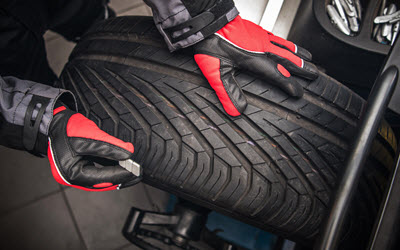Car vibrations can indicate a range of underlying issues, including problems with the tires, wheels, brakes, suspension, or engine. So, addressing these vibrations promptly is essential as they can worsen over time. The timing and location of the vibrations are also important.
The timing and location of the vibrations can help diagnose the cause, such as high-speed vibrations indicating tire issues or shaking during braking, which suggests brake rotor problems.
Possible Causes For Why Your Car Is Vibrating
- Tire and Wheel Problems: Unbalanced wheels will feel like rhythmic vibration that intensifies with speed. A tire that has lost a wheel weight or has uneven wear can cause a wobble as it rotates. Hitting a pothole or curb can bend a wheel’s rim, causing the entire wheel assembly to wobble as it rotates. If the tires are worn unevenly, then it can create a bouncy or vibrating sensation. This can be caused by improper alignment, incorrect tire pressure, or failing suspension components. A tire with a separated tread, a bulge, or a flat spot can cause persistent vibration that may be felt at lower speeds.
- Brake System Problems: Rotors are the metal discs that the brake pads clamp onto. Heavy use can cause warped or uneven thickness due to excessive heat. This can create a shaking sensation through the brake pedal and steering wheel when the brakes are applied. A stuck brake can cause a pad to constantly drag on the rotor, leading to uneven wear, vibration, and a burning smell. Brake pads that are worn too thin or have worn unevenly can cause a pulsating sensation when braking.
- Suspension and Steering Issues: Damaged or worn components, such as ball joints, tie rods, and struts, are designed to absorb road shock. When they fail, it leads to a feeling of bump and imperfection in the road—certain noises, such as hearing a clunking noise over bumps, and experiencing a loose steering wheel. If the wheels are out of alignment, then it can cause uneven tire wear and cause the car to shake at higher speeds. This can also cause the vehicle to pull to one side. Worn or loose wheel bearings can also cause wobble and an audible grinding or humming noise that increases in volume with speed.
- Engine and Transmission Problems: Worn or broken engine mounts can’t absorb the engine vibrations, which get transferred to the cabin, especially at idle. A misfiring cylinder, caused by old spark plugs, a clogged fuel filter, or a dirty air filter, can cause the engine to run roughly and shake the entire car. Low transmission fluid levels can cause vibrations due to increased friction and wear within the transmission.
- Drive train Problems: A bent or damaged axle will cause a vibration that increases in intensity when accelerating. Worn constant velocity or universal joints can cause shaking during acceleration or while turning. If the drive shaft is unbalanced, it can cause vibration that becomes more pronounced at higher speeds.
A Guide to Fix Your Vibrating Car
- For unbalanced wheels, use a specialized machine to ensure the weight is distributed evenly. This service should be performed in conjunction with tire rotation and can help resolve the vibrations felt at a specific speed.
- For warped brake rotors, the only solution is a complete replacement. Both rotors on the same axle should be replaced simultaneously to ensure even braking.
- For sticking brake calipers and worn pads, they should be inspected and repaired by a mechanic, as they can be caused by debris or worn hoses. Worn brake pads shall be replaced with new ones to prevent damage to the rotors.
- For worn suspension components, a mechanic will perform a thorough inspection to identify the affected parts, such as ball joints, tie rods, and struts. These components also need to be replaced.
- For damaged axles or driveshafts, a professional mechanic needs to check and correct the alignment of the transmission and differential mounts, and replace them if necessary.
- For engines and transmissions, inspect for any signs of deterioration or loosening, and replace them when needed.
Where to Find Reliable Solutions for High-Speed Vibration Problems?
Resolving these high-speed vibration problems is  a complex task that needs specialized diagnostics, expertise, and precision corrective actions. Whether it is a cause of imbalance, misalignment, resonance, or mechanical wear, ignoring these issues can lead to reduced efficiency, increased maintenance costs, and catastrophic failures. For such complex problems, our team at Huron Automotive, located in Green Bay, can perform vibration analysis, precision balancing, and strategic maintenance that can ensure the longevity and reliability of your high-speed assets.
a complex task that needs specialized diagnostics, expertise, and precision corrective actions. Whether it is a cause of imbalance, misalignment, resonance, or mechanical wear, ignoring these issues can lead to reduced efficiency, increased maintenance costs, and catastrophic failures. For such complex problems, our team at Huron Automotive, located in Green Bay, can perform vibration analysis, precision balancing, and strategic maintenance that can ensure the longevity and reliability of your high-speed assets.
